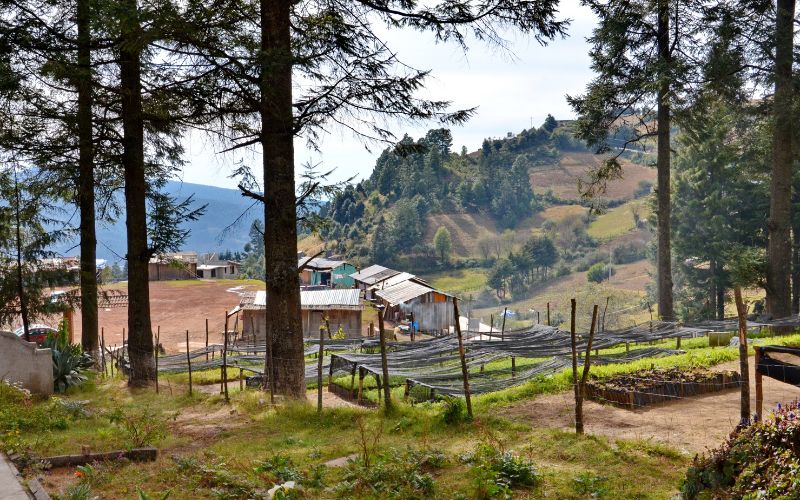All About The Monarch Butterfly and Day of the Dead
Inside: Learn about monarch butterflies and Day of the Dead and get lesson plans and resources for students.
Each winter, millions of monarch butterflies make the long journey south from the United States and Canada, to escape the coming winter.
Catching air currents, they soar thousands of miles to the state of Michoacán in central Mexico. The butterflies find warmth and refuge in the local oyamel fir forests, and hibernate there several months.
The arrival of the monarchs fills the sky with fluttering orange wings, just at the time of Día de Muertos festivities. For some communities, this is extra meaningful: in their traditions, the mariposas are the souls of their ancestors, returning to earth for a brief visit.
Mexican writer Alfredo Avalos recounts,
As children we weren’t always aware of time, but we knew Día de los Muertos was close when monarch butterflies started arriving in our town. In the late seventies in San Luis Potosí nobody knew about the incredible migration from Mexico to Canada and back these remarkable creatures would make over multiple generations. We didn’t even know they were called monarchs.
– Texas Butterfly Ranch, A Monarch at my Abuela’s Day of the Dead Altar
Nobody needed that information–we just knew they were souls of dead people coming back to visit. That is why trapping monarchs was forbidden, unlike other species that we caught in nets. Monarchs were sacred, because no one wanted to trap a soul.

Monarch butterflies mean different things to the diverse Dia de Los Muertos celebrations across Mexico. In this post, we’ll explore the connections and beliefs surrounding these beautiful creatures!
Contents:
1. Day of the Dead Celebrations in Mexico
2. An Introduction to Monarch Migration
3. Resources for Teachers and Kids
Day of the Dead Celebrations in Mexico
Día de los Muertos is celebrated every November 1st and 2nd in Mexico. It’s a time to welcome the visiting souls of ancestors and family members and honor their memories. The rituals draw from pre-Hispanic beliefs, mixed in with Catholic traditions, especially from All Souls Day and All Saints Day.
Communities hold parades, visit the cemetery to adorn graves and might decorate the streets, but the central traditional is the ofrenda (altar). Families erect ofrendas for their relatives, decorating them with candles, marigolds and other flowers, sugar skulls, pan de muerto and other treats, papel picado, and more.
The arrival of the monarchs just happens to coincide with these celebrations– and for some groups, this holds significant meaning.
Butterflies are a common symbol for life and death in many places, including indigenous cultures from pre-hispanic times. Those cultures tended to see death as a natural part of life, and a natural transition for human souls to travel to Mictlan (the afterlife). Butterflies are commonly included in carvings and other art.
Warriors – just like flowers and butterflies – were expected to live short but glorious lives….butterflies represented to the Aztecs the souls of dead heroes, of warriors who fell on the battlefield or died in sacrifice, or of women dying in childbirth (who were also considered warriors) (2004: 300). Butterflies and flowers were ‘central components in the solar war cult’ (Taube 2001: 107) and warriors can be seen bearing butterfly paraphernalia into battle, such as a butterfly-shaped pectoral on the chest (see pic 4).
– Mexico Lore
This burst of glory – what today we might refer to as ‘going out with a bang’ – stems too in part from the dramatic life cycle of a butterfly, as it suddenly erupts from dormant chrysalis stage into vigorous life. Mirroring this, dead warriors were wrapped in cloth bundles and burned, their souls flying up to accompany the sun.
Monarch Butterfly Migration
Every fourth or fifth generation of North American monarch butterflies makes an incredible journey south. They escape the coming winter by either traveling to California or Mexico. For some monarchs, this means traveling south, either to California or Mexico.
Most monarchs only live two to six weeks. These generations are born in the spring, in the south. Each generation slowly migrates north, consuming milkweed as they go and passing through the monarch life cycle of egg, caterpillar, pupa, and then butterfly.
Milkweed is a native plant in the U.S. and Canada and is a host plant for monarchs, for laying eggs. While its leaves are the sole source of sustenance at the caterpillar stage, adult butterflies drink nectar from a variety of flowers.
The “super generation” born in the fall, however, is larger and lives longer. Before winter, they must migrate south, catching air currents. Their destination is Michoacan, Mexico, where they nestle into oyamel fir trees and hibernate the whole winter.
Scientists aren’t exactly sure how the butterflies know how to navigate their way year after year: it’s a trip they make once in their lifetime. They believe that the butterflies are guided by the position of the sun and magnetic forces in the earth.
One aspect of the monarch butterfly’s migration that has long puzzled scientists is how the tiny insects navigatesuch extended journeys. A neurobiologist at the University of Massachusetts Medical School, Dr. Steven Reppert, has been researching the monarch butterfly’s migration for years.
Reppert believes the insects use the sun, or rays of the sun, to determine their location. Specific chemical proteins in the butterfly’s brain help it to use the sun as a compass. Monarchs can interpret the sun’s position in the sky to help them fly from the northern United States, through Texas, and into Michoacán.
– National Geographic, Monarch Migration Mystery
Monarch butterflies are under threat, and their population has drastically diminished– some estimate a decline of up to 80%. The species that migrates to Mexico (Danaus plexippus plexippus) has been named an endangered species. This is due to several causes, such as climate change, the loss of milkweed from pesticides in the U.S., and desforestation among the Mexican oyamel fir forests, have also devastated the species.
There are conservation efforts to plant and protect native plants like milkweed, along with wildlife groups that fight deforestation to combat habitat loss.
Lesson Plans and Resources for Kids
Learning about Monarch butterflies is a beautiful introduction to Day of the Dead for children, and also a perfect option for any students who need an alternative to Dia de Los Muertos activities.
Elementary Students:
Spanish Playground has a great blog post with a printable mini-book in Spanish, all about monarchs.
Butterfly Life Cycle free Game from Fun for Spanish Teachers
Free Color-by-Number butterfly page for colors in Spanish. (TpT)
Adorable mini-book and activity for the butterfly life cycle in Spanish.
Free cut-and-paste life cycle sequencing page in English and Spanish. (TpT)
Middle and High School Spanish Students:
I have a free reading about butterflies and migration in Spanish, with questions and activities.
More Connections with the Monarch Butterfly and Day of the Dead
The egg— Like the child in a mother’s womb, the egg is growing and getting ready to enter the world.
The caterpillar—From our day of birth, we are like the caterpillar which eats and creeps along from day to day.
The pupa—at death, we are like the dormant pupa in its chrysalis waiting to be ready for our next transformation.
The butterfly—As the butterfly emerges from the chrysalis, it symbolizes our spirit as it emerges from the cast off body.
– CT Science Center
The ancient Maya believed that butterflies were the spirits of their ancestors coming to visit them and assure them all is well. These butterflies flew around the house and around bouquets of flowers.
This video (in English) is a beautiful introduction for kids. It’s a clip from One Strange Rock, narrated by Will Smith.
Before we paint too broad a brush, it’s important to remember that not all indigenous Mexican groups share these beliefs about butterflies and Day of the Dead.
For example, many places report that the Purépecha group in the village of Angangueo in the Sierra Made hills hold these beliefs about monarchs. However, this video shows an investigation revealing that it is not common as once thought.
This is a really poignant video from the perspective of communities near Chicago, highlighting efforts to protect the monarch butterfly population:
Narrated video in Spanish explaining the life cycle of butterflies:











